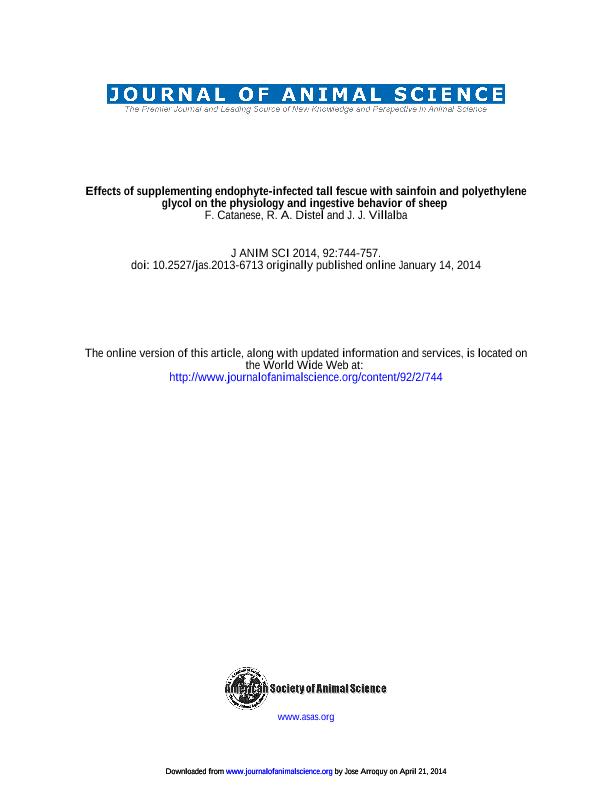Mostrar el registro sencillo del ítem
dc.contributor.author
Catanese, Francisco Hernan

dc.contributor.author
Distel, Roberto Alejandro

dc.contributor.author
Villalba, Juan Jose

dc.date.available
2017-01-16T20:04:21Z
dc.date.issued
2014-02
dc.identifier.citation
Catanese, Francisco Hernan; Distel, Roberto Alejandro; Villalba, Juan Jose; Effects of supplementing endophyte-infected tall fescue with sainfoin and polyethylene glycol on the physiology and ingestive behavior of sheep; American Society Of Animal Science; Journal Of Animal Science; 92; 2; 2-2014; 744-757
dc.identifier.issn
0021-8812
dc.identifier.uri
http://hdl.handle.net/11336/11428
dc.description.abstract
Tannins in sainfoin (Onobrychis viciifolia) may bind to alkaloids in endophyte-infected tall fescue [E+; Lolium arundinaceum (Schreb.) Darbysh.] and attenuate toxicosis. If so, supplementing E+ with sainfoin will increase use of E+ by sheep, and polyethylene glycol (PEG)—a polymer that selectively binds to tannins—will reduce such response. To test these predictions, thirty-six 2-mo-old lambs were randomly assigned to 3 treatments (12 lambs/treatment). During exposure, all lambs were individually penned and fed E+ supplemented with beet pulp (CTRL), freshcut sainfoin and beet pulp (SAIN), or fresh-cut sainfoin plus PEG mixed in beet pulp (SAIN+PEG). Feed intake was measured daily. Rectal temperatures and jugular blood samples were taken at the beginning and end of exposure. After exposure, all lambs were offered choices between endophyte-free tall fescue (E–) and orchardgrass, and preference for E– was assessed. Then, all lambs were allowed to graze a choice of E+ and sainfoin or a monoculture of E+. The foraging behavior of lambs was recorded. When sainfoin was in mid-vegetative stage, lambs in SAIN ingested more E+ than lambs in CTRL (P = 0.05), but no differences were detected between lambs in SAIN+PEG and CTRL (P = 0.12). Sainfoin supplementation improved some physiological parameters indicative of fescue toxicosis. Lambs in SAIN had lower rectal temperatures (P = 0.02), greater numbers of leukocytes (P < 0.001) and lymphocytes (P = 0.03), and greater plasmatic concentrations of globulin (P = 0.009) and prolactin (P = 0.019) than lambs in CTRL. Some of these differences were offset by the SAIN+PEG treatment. When lambs were offered choices between E– and orchardgrass, only lambs in SAIN had greater intake of E– than lambs in CTRL (P < 0.001). When lambs were allowed to graze a choice of E+ and sainfoin, all treatments used E+ to the same extent (P > 0.05). On the other hand, when they grazed on a monoculture of E+, lambs in SAIN+PEG showed greater acceptance of E+ than lambs in SAIN or in CTRL (P < 0.05). In summary, sainfoin supplementation alleviated several of the classic signs of fescue toxicosis and increased intake of endophyte-infected tall fescue. Tannins in sainfoin partially accounted for this benefit since feeding a polymer that selectively binds to tannins (PEG) attenuated some these responses. However, sainfoin supplementation during initial exposure to E+ did not lead to an increased preference for E+ during grazing.
dc.format
application/pdf
dc.language.iso
eng
dc.publisher
American Society Of Animal Science

dc.rights
info:eu-repo/semantics/openAccess
dc.rights.uri
https://creativecommons.org/licenses/by-nc-sa/2.5/ar/
dc.subject
Alkaloids
dc.subject
Condensed Tannins
dc.subject
Fescue Toxicosis
dc.subject
Ingestive Behavior
dc.subject
Sainfoin
dc.subject
Sheep
dc.subject.classification
Ganadería

dc.subject.classification
Producción Animal y Lechería

dc.subject.classification
CIENCIAS AGRÍCOLAS

dc.title
Effects of supplementing endophyte-infected tall fescue with sainfoin and polyethylene glycol on the physiology and ingestive behavior of sheep
dc.type
info:eu-repo/semantics/article
dc.type
info:ar-repo/semantics/artículo
dc.type
info:eu-repo/semantics/publishedVersion
dc.date.updated
2017-01-13T19:50:21Z
dc.journal.volume
92
dc.journal.number
2
dc.journal.pagination
744-757
dc.journal.pais
Estados Unidos

dc.description.fil
Fil: Catanese, Francisco Hernan. Consejo Nacional de Investigaciones Científicas y Técnicas. Centro Científico Tecnológico Bahía Blanca. Centro de Recursos Naturales Renovables de la Zona Semiárida(i); Argentina. Universidad Nacional del Sur. Departamento de Agronomía; Argentina
dc.description.fil
Fil: Distel, Roberto Alejandro. Consejo Nacional de Investigaciones Científicas y Técnicas. Centro Científico Tecnológico Bahía Blanca. Centro de Recursos Naturales Renovables de la Zona Semiárida(i); Argentina. Universidad Nacional del Sur. Departamento de Agronomía; Argentina
dc.description.fil
Fil: Villalba, Juan Jose. State University Of Utah; Estados Unidos. Consejo Nacional de Investigaciones Científicas y Técnicas; Argentina
dc.journal.title
Journal Of Animal Science

dc.relation.alternativeid
info:eu-repo/semantics/altIdentifier/url/https://www.animalsciencepublications.org/publications/jas/articles/92/2/744
dc.relation.alternativeid
info:eu-repo/semantics/altIdentifier/doi/http://dx.doi.org/10.2527/jas.2013-6713
Archivos asociados
